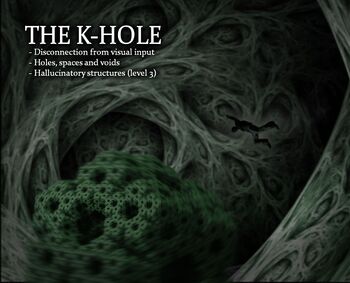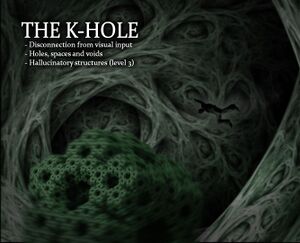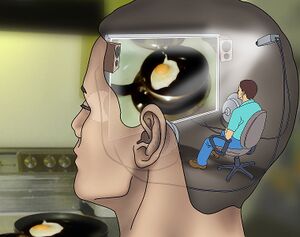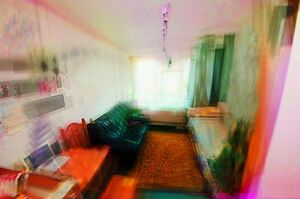Disconnective effects
Disconnective effects are defined as any subjective effect which feels as if it detaches or disconnects one from the external environment, their senses, and their consciousness.
These effects are typically associated with dissociative hallucinogens and likely occur due to the way in which these compounds function as NMDA receptor antagonists. This means they bind to the receptor, but do not activate it and block other neurotransmitters from doing so. The result is a dose-dependent decrease in the passing of electrical signals across the brain and an overall disconnection of neurons, which leads to states of disconnection between conscious parts of the brain and its sensory organs.
This page lists and describes the various disconnective effects which can occur under the influence of certain psychoactive compounds.
Cognitive disconnection
Cognitive disconnection is the experience of feeling distant and detached from one's sense of identity, thought stream, and general cognitive processes. This leads into states such as depersonalisation, derealisation, memory suppression, "ego death" and a general array of cognitive suppressions. The experience of this can also create a wide range of subjective changes to a person's perception of their own consciousness. These are described and documented in the list below:
- Feeling as though one's conscious thought stream and memories are not one's own
- Feeling as if one's conscious thought processes are distant and vague
- Feeling as if one's conscious thought processes have become autonomous and mechanical in their structure or behaviour
- Feeling a decrease in the overall speed, connectivity, and analytical abilities of one's cognitive abilities
Cognitive disconnection is often accompanied by other coinciding effects such as visual disconnection and tactile disconnection. This results in the sensation that one is partially or completely detaching from both their sensory input and their conscious faculties. It is a near universal effect under the influence of moderate dosages of dissociative compounds, such as ketamine, PCP, and DXM.
Déjà vu
Déjà Vu (or Deja Vu) is defined as as any sudden inappropriate impression of familiarity of a present experience with an undefined past.[1][2][3][4] Its two critical components are an intense feeling of familiarity, and a certainty that the current moment is novel.[5] This term is a common phrase from the French language which translates literally into “already seen”. It is a well-documented phenomenon that can commonly occur throughout both sober living and under the influence of hallucinogens.
Within the context of psychoactive substance usage, many compounds are commonly capable of inducing spontaneous and often prolonged states of mild to intense sensations of déjà vu. This can provide one with an overwhelming sense that they have “been here before”. The sensation is also often accompanied by a feeling of familiarity with the current location or setting, the current physical actions being performed, the situation as a whole, or the effects of the substance itself.
This effect is often triggered despite the fact that during the experience of it, the person can be rationally aware that the circumstances of the “previous” experience (when, where, and how the earlier experience occurred) are uncertain or believed to be impossible.
Déjà vu is often accompanied by other coinciding effects such as olfactory hallucinations and derealization.[6] It is most commonly induced under the influence of moderate dosages of hallucinogenic compounds,[7] such as psychedelics,[8] cannabinoids,[9] and dissociatives.
Detachment plateaus
This article does not represent an individual subjective effect component but instead serves as a generalised leveling system which can be applied to the simultaneous experience of disconnective effects such as cognitive, physical, and visual disconnection. These effects are most commonly induced under the influence of light to heavy dosages of dissociative compounds, such as ketamine, PCP, and DXM.
This process of sensory and cognitive detachment can be broken down into the 5 basic levels of intensity described below:
- Subtle detachment from environment - At the lowest level, the effects can be described as a subtle dulling of the senses and a vague sense of subjective detachment from the external environment.
- Partial detachment from environment - At this level, the environment starts to feel physically further away in distance and increasingly disconnected from a person's sensory perception. Blurred and double vision sets in while anaesthetic-like effects and tactile numbness begin to take place. At this point, motor control, coordination, and balance become suppressed in a manner that is proportional to dosage. In terms of sound, hearing also seems to become vague, muffled, and distant.
- Total detachment from environment - At this level, the sensory and cognitive disconnection have completely blocked out one's perception of the external environment. It is here where the person finds themselves undergoing an out-of-body experience as they enter a dissociative hole which is often accompanied by internal hallucinations.
- Detachment from self - At the highest level, the dissociation and detachment has become intense enough for a person's long-term memory to cease functioning. This leads into a state which is commonly referred to as "ego death" as the person loses their ability to recall and comprehend their own sense of identity.
- Detachment from awareness - The highest level of detachment occurs when a person loses all sensory awareness and normal cognitive functioning. This renders the person unconscious and consistently leaves extended gaps in a person's memory with large periods of amnesia which are generally impossible to recall once the experience is over. It's at this level that dissociatives such as ketamine are used in medical procedures for their anesthetic effects.[10]
Physical disconnection
Physical disconnection is the experience of feeling distant and detached from one's sense of touch and their feelings of ownership and control over their own physical body. This leads into states such as tactile suppression, physical autonomy, pain relief, changes in felt bodily form, a perception of bodily lightness, and a general array of physical suppressions. The experience of this effect can also create a wide range of subjective changes to a person's perception of their own body. These are described and documented in the list below:
- Feeling as if one's body is not their own
- Feeling as if one's body is controlling itself
- Feeling as if one's body is distant and far away
- Feeling as if one's bodily movement is mechanical and robotic
- Feeling a decrease in one's ability to use fine motor control
- Feeling a decrease in one's ability to use and perceive their sense of touch
Physical disconnection is often accompanied by other coinciding effects such as cognitive disconnection and visual disconnection in a manner which results in the sensation that one is partially or completely detaching from both their sensory input and their cognitive faculties. This effect is most commonly induced under the influence of moderate dosages of depressant and dissociative compounds, such as, ketamine, PCP, and DXM.
Visual disconnection
Visual disconnection is the experience of becoming distant and detached from one's sense of vision. At its lower levels, this leads to states such as visual acuity suppression, double vision, pattern recognition suppression, and visual processing deceleration. The experience of this effect can also create a wide range of subjective changes to a person's perception of their own vision. These are described and documented in the list below:
- Feeling as if one is watching the world through a screen
- Blurred vision and a general difficulty in perceiving fine details
- Feeling as if the visually perceivable world is more distant
- Feeling as if one is looking at the world through someone else's eyes
- A Double vision which, at higher levels, forces the user to close one eye if they need to read or perceive fine visual details
Visual disconnection is often accompanied by other coinciding effects such as cognitive disconnection and physical disconnection in a manner which results in the sensation that one is partially or entirely detaching from both their sensory input and their cognitive faculties. This effect is most commonly induced under the influence of moderate dosages of depressant and dissociative compounds, such as, ketamine, PCP, and DXM.
At its higher levels, visual disconnection can become all-encompassing in its effects. This results in a complete perceptual disconnection from one's sense of sight which can be described as the experience of being blinded and unable to tell whether the eyes are open or closed due to a total lack of sensory input. During this state, the effect often leads one into the experience of finding themselves floating through a dark and mostly empty hallucinatory void.
Image examples
Holes, spaces and voids

Holes, spaces and voids are a sub-component of visual disconnection that manifests when it has become all-encompassing in its intensity. This experience is more commonly known within the literature as the "K-hole" and is generally discussed as something which is associated specifically with ketamine despite being present within most traditional dissociatives. It can be described as the place a person finds themselves at once visual disconnection becomes powerful enough to leave the person incapable of receiving external sensory input. This replaces their visual input with a space that subjectively feels as if it is outside of ordinary reality.
The visual appearance of this space, hole, or void can be described as a vast, mostly empty and darkened chamber which often feels and appears to be infinite in size. This space is usually dark black but can occasionally display itself with large patches of slow-moving amorphous colour clouds or subtle geometric patterns across its horizon. At its higher levels, these voids are often populated with hallucinatory structures which are comprehensively described and documented in the subsection below.
Alongside this visual experience changes in gravity and a powerful sense of tactile disconnection are also usually present which can result in one feeling as if they are undergoing an out-of-body experience while weightlessly floating through a void over great distances in a variety of different speeds, directions, and orientations. This is a feeling that is interpreted by many people as floating through space or the night sky.
Structures
Structures are the only feature found within what would otherwise be empty and uninhabited voids. These manifest as the visual experience of monolithic 3-dimensional shapes or structures of an infinite variety and size which float above, below, around, or in front of a person as they gradually zoom, rotate, transform, or pan into focus and become unveiled before the person's line of sight at a gradual pace.
These structures can take the form of any shape but common examples include vast and giant pillars, columns, tunnels, blocks, buildings, slides, monuments, wheels, pyramids, caves, and a variety of abstract shapes. They are often fractal in shape and can manifest in a variety of colours, but usually follow darker themes and tones with an associated aesthetic that is sometimes subjectively interpreted as "alien" in nature.
Structures can be broken down into the 4 basic levels of complexity and visual intensity described below:
- 2-Dimensional Structures - At the lowest level, structures confine their form to strictly 2-Dimensional shapes. These shapes are usually flat and dark in their colour. Their presence is also often “felt” instead of seen. In terms of their size, these structures usually take up the entirety of a person's visual field but do not appear to have any particular sense of size attributed to them.
- Partially defined 3-Dimensional Structures - At this level, the structures become better defined and 3-dimensional in shape with some basic detail to their lighting and shadows. They appear to be comprised of semi-transparent condensed colour and are seen as ill-defined or out of focus around their edges. In terms of size, these structures appear to be extremely large, stretching out across up to hundreds of meters.
- Fully defined 3-Dimensional Structures - At this level, structures become fully defined in their shape, edges, lighting, shadow, and detail. They often appear to be made of solid and dense realistic materials such as stone and metal. In terms of their size, they are capable of appearing as thousands of miles across themselves and are often extremely complex in terms of their shape and texture.
- Structural machine-universes - At its highest level, hallucinatory structures can be described as the sensation of seeing that which is subjectively perceived as the entire universe condensed into an infinitely vast and intricate ever-shifting machine structure. In terms of its appearance, this state is tough to describe but has many subjective similarities to level 8A geometry. The structure can take any form, but usually, appear as intricately shaped machine-like structures that are seemingly infinite in size and can convey vast amounts of innately understandable information. This experience is not just perceived through one's sense of sight but is also physically felt in an incomprehensible level of detail that manifests itself as complex cognitive and tactile sensations. The structure as a whole and the information it conveys are often innately interpreted as perceiving a structural representation of “the universe” or “everything”.
Structures typically display themselves from anywhere between 30 seconds to several minutes before the person experiencing them slips back into reality or the presence of another structure. In terms of how these structures shift between each other, their transition processes can be broken down into 4 basic categories. These are described and documented below:
- Structural transformations - Structures can switch between each other by transforming or shapeshifting in a static and comprehensible way. This is something that usually unfolds in a gradual step by step morphing process.
- Structural panning - Structures can switch between each other by remaining static in their shape but merely panning out of view until they are no longer within one's field of vision. It’s from here that another structure usually comes into view from outside of one's peripheral vision within a few seconds to a couple of minutes.
- Traveling over great distances - The third method of transitioning is experienced when the structures appear to be stationary while one is floating silently between them over what can feel like extreme physical distances. This floating is sometimes felt to occur on an invisible rail through the vast and infinite dissociative hole.
See also
References
- ↑ O’Connor, A. R., Wells, C., Moulin, C. J. A. (9 August 2021). "Déjà vu and other dissociative states in memory". Memory. 29 (7): 835–842. doi:10.1080/09658211.2021.1911197. ISSN 0965-8211. Retrieved 16 June 2022.
- ↑ Funkhouser, A. T., Schredl, M. (2010). "The frequency of déjà vu (déjà rêve) and the effects of age, dream recall frequency and personality factors". doi:10.11588/IJODR.2010.1.473. Retrieved 16 June 2022.
- ↑ Brown, A. S. (2003). "A review of the déjà vu experience". Psychological Bulletin. 129 (3): 394–413. doi:10.1037/0033-2909.129.3.394. ISSN 1939-1455.
- ↑ Wild, E. (January 2005). "Deja vu in neurology". Journal of Neurology. 252 (1): 1–7. doi:10.1007/s00415-005-0677-3. ISSN 0340-5354. Retrieved 16 June 2022.
- ↑ O’Connor, A. R., Moulin, C. J. A. (June 2010). "Recognition Without Identification, Erroneous Familiarity, and Déjà Vu". Current Psychiatry Reports. 12 (3): 165–173. doi:10.1007/s11920-010-0119-5. ISSN 1523-3812.
- ↑ Warren-Gash, C., Zeman, A. (1 February 2014). "Is there anything distinctive about epileptic deja vu?". Journal of Neurology, Neurosurgery & Psychiatry. 85 (2): 143–147. doi:10.1136/jnnp-2012-303520. ISSN 0022-3050. Retrieved 16 June 2022.
- ↑ Doss, M. K., Samaha, J., Barrett, F. S., Griffiths, R. R., Wit, H. de, Gallo, D. A., Koen, J. D. (2022), Unique Effects of Sedatives, Dissociatives, Psychedelics, Stimulants, and Cannabinoids on Episodic Memory: A Review and Reanalysis of Acute Drug Effects on Recollection, Familiarity, and Metamemory, Neuroscience, retrieved 16 June 2022
- ↑ Luke, D. P. (2008). "Psychedelic substances and paranormal phenomena: a review of the research". Journal of Parapsychology. 72: 77–107. ISSN 0022-3387. Retrieved 16 June 2022.
- ↑ Basu, D., Malhotra, A., Bhagat, A., Varma, V. K. (1999). "Cannabis Psychosis and Acute Schizophrenia". European Addiction Research. 5 (2): 71–73. doi:10.1159/000018968. ISSN 1022-6877. Retrieved 16 June 2022.
- ↑ Mashour, G. A. (23 June 2014). "Top-down mechanisms of anesthetic-induced unconsciousness". Frontiers in Systems Neuroscience. 8: 115. doi:10.3389/fnsys.2014.00115. ISSN 1662-5137.



